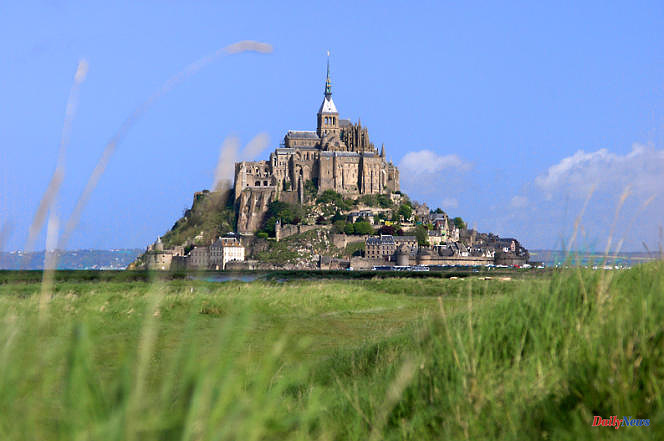President Emmanuel Macron is due to visit Mont Saint-Michel on Monday, June 5, on the occasion of the thousand years of the abbey. A historic monument listed as a UNESCO World Heritage Site since 1979 and visited by 1.3 million tourists each year, the mountain is also the subject of one of the most famous disputes in the country. Bretons and Normans regularly fight over the belonging of the famous rock.
The long history of the "Wonder of the West", as it is sometimes called, is however well known and documented by historians. It began in the year 709 on what was then only a four-hectare granitic rock, emerging within a wide bay on the border between Avranchin, in the south of the current department of Manche, and the Breton kingdom of Domnonée, in which stands the famous rock.
A modest first church
In this year 709, therefore, Aubert, bishop of Avranches, had a modest first church built on the virgin rock after - according to legend - the Archangel Michael had appeared to him three times to order him to do so. Despite the difficulty of access to the rock, which earned it the nickname "Mont Saint-Michel au peril de la mer", the church, where a dozen canons officiate, welcomes many pilgrims and slowly increases its fame.
In 849, one hundred and forty years later, the merger of the small kingdoms that made up Armorican Brittany gave birth to the unified kingdom of Brittany, which two years later annexed the eastern part of Armorica and the lands on which the mountain is located. It is then still in Breton land, and not in Avranchin, which is delimited by the Sélune (a river to the east of the mountain).
The Viking raids on France intensifying throughout the 9th century, the King of France Charles the Bald could not fight on all fronts against the Scandinavian invasions and decided to cede Cotentin (and Avranchin) in 867 to the young kingdom of Britain and its third king, Solomon, in exchange for his help in repelling the Viking assaults. The diocese of Avranches moved to Brittany, but remained attached to the archdiocese of Rouen. The mount remained in Brittany.
This situation, complicated to say the least, did not last very long, since Raoul, King of the Franks, returned Cotentin to the Duchy of Normandy in 933.
Neither Norman nor Breton: an "unsubdued" mountain
Fearing the Breton influence on the mountain, Richard 1st, Duke of Normandy, decided to set up a community of around thirty Benedictine monks from the Abbey of Saint-Wandrille (Seine-Maritime) in order to replace the previous monks, considered too close to the Count of Rennes and having neglected their mission. A church (Notre-Dame-sous-Terre) is then raised on the rock and dominates it.
From 966 to the beginning of the following century, the development of the activity of Mont Saint-Michel continued in a relatively independent way, far from Rouen power. Norman domination is evanescent. Directed by non-Norman abbots and populated by Frankish monks for the most part, the abbey conducts its own policy of heritage expansion, regardless of borders. It took advantage in particular of the absence of a bishop in Avranches until 990. The founding text of the Benedictine abbey also mentions the right of its community to the free election of the abbot. Until the beginning of the 11th century, the mountain was neither Breton nor Norman, but primarily Benedictine.
In the 11th century, the Norman takeover
At the beginning of the 11th century, the Normans gradually intensified their efforts to dominate the region of Mont Saint-Michel. In 1009, Richard II demonstrated a first act of authority by imposing Abbot Hildebert on the Benedictine community, thanking the former Abbot Mainard II in passing.
Shortly after his accession to power, in 1027, Robert I of Normandy decided to push the border of Avranchin, then delimited by the Sélune, to another river, the Couesnon, passing the rock definitively in land. Normans. Along with territorial control, the Normans undertook the first large-scale constructions on the rock. From 1023 to 1085, the construction of the abbey church is engaged on the upper plateau of the rock, above Notre-Dame-sous-Terre, which is reinforced and surrounded by crypts built to receive the imposing abbey of 80 meters length.
Then, from 1212 to 1228, the imposing building nicknamed "the Marvel" will be built on the north face of the rock. This spectacular Gothic building, 35 meters high and supported by sixteen powerful buttresses, is considered a technical feat. Today it constitutes the northern limit of human constructions founded on the rock (with the exception of the Saint-Aubert chapel, built almost at bay level).
Could Le Couesnon have changed his bed?
The activities and the community of the mount will grow as much as its fame in the Christian world. The mountain took on its current pyramidal shape in 1897, when the copper spire and the sculpture representing Saint Michael, enthroned 160 meters above the bay, were installed at the top of the abbey. Its fame will grow further with the rise of tourism, which will make it the second most visited monument in France.
A status that has since attracted many desires on the other side of the Couesnon. It is precisely on the bed of this watercourse that the Breton claims of today are based to argue the past ownership of Mont Saint-Michel. And it is true that the river may indeed have changed its bed, as the presence of the town of Roz-sur-Couesnon, 5 kilometers west of its current bed, may suggest. But without written records of such an event, it will be difficult to verify that one day “the Couesnon, in his madness, put the mount in Normandy. »
Beyond historical differences, Mont Saint-Michel remains a common tourist and cultural issue that the two regions know how to value and preserve. Evidenced by the major de-silting work on the mountain that each bank of the Couesnon has financed.
Sources: Bretons and Normans in the Middle Ages – Rivalries, Misunderstandings, Convergences, edited by Bernard Merdrignac and Joëlle Quaghebeur (Presses Universitaires de Rennes, 2008) and Le Mont-Saint-Michel, 13 centuries of history, by Henry Decaens ( Editions Ouest-France, 2008)












